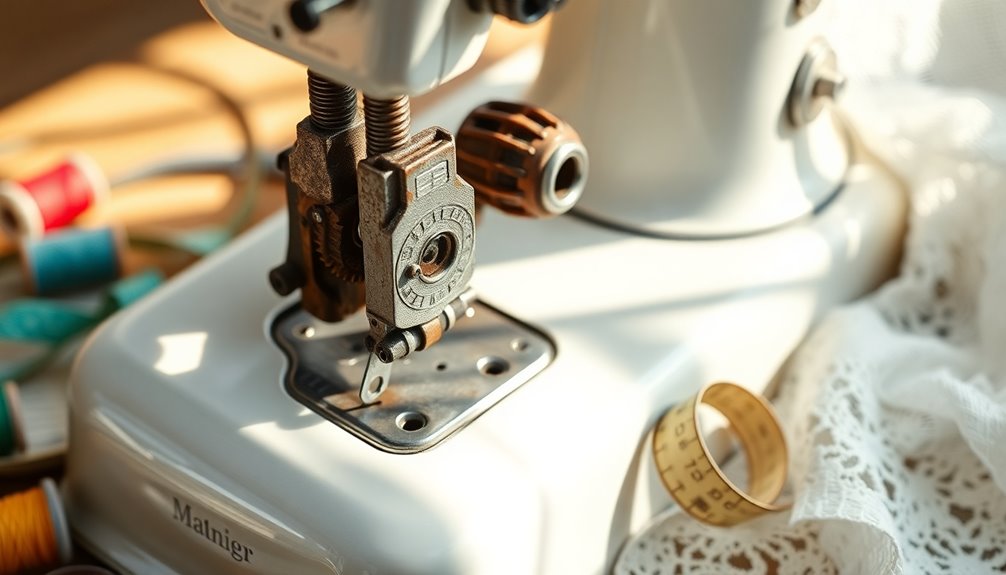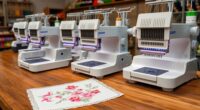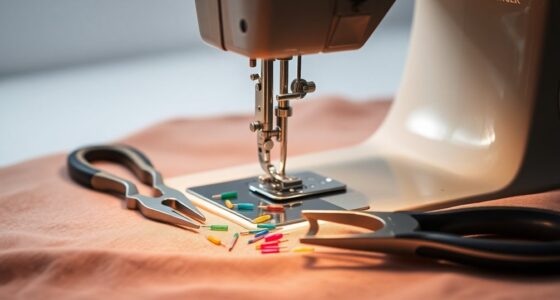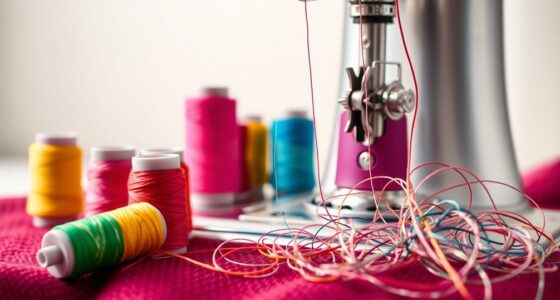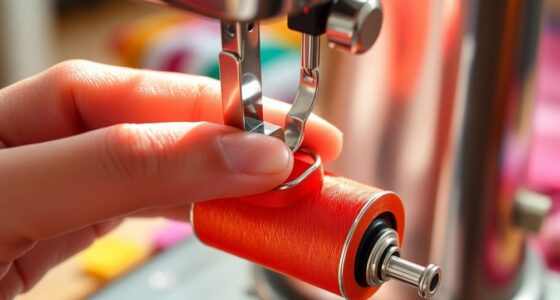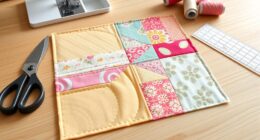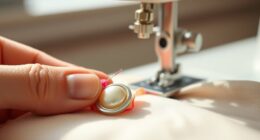Yes, old White sewing machines can be worth quite a bit, depending on their rarity, age, and condition. Common models might sell for around $100 to $400, while rare ones like the White Gem can fetch over $1,000. A fully operational machine in excellent shape will always attract higher prices. If you want to understand more about evaluating value and buying or selling these vintage treasures, there's plenty more to explore.
Key Takeaways
- Vintage White sewing machines can range in value from under $100 to over $1,000, depending on rarity and condition.
- Models like the White Gem are highly sought after and can fetch prices exceeding $1,000 due to their limited production.
- A fully operational White Rotary from 1919 typically values around $400, while machines in poor condition may only be worth $25 to $100.
- Key factors determining worth include age, rarity, condition, and aesthetic appeal, such as intact decals and original parts.
- Market demand can be assessed through platforms like eBay, providing insights into current pricing trends for vintage machines.
Understanding the Value of Old White Sewing Machines

When you're looking to understand the value of old White sewing machines, it's essential to take into account several key factors.
Vintage sewing machines can vary widely in price, typically ranging from under $100 to over $1,000. Antique sewing machines, like the White Gem or Peerless, usually command higher prices due to their rarity.
For instance, a fully operational White Rotary from 1919 might be valued around $400, emphasizing how condition plays a significant role in determining the value.
Additionally, unique features such as original cabinets and manuals can enhance worth.
Keep an eye on market demand through platforms like eBay, as current sales data provides valuable insights into real-time pricing trends for these cherished machines.
Key Factors Influencing the Worth of White Sewing Machines

Several key factors influence the worth of White sewing machines, making it essential for collectors and sellers to understand them.
Here are three critical aspects to evaluate:
- Rarity: Rare models like the White Gem can fetch higher prices compared to common ones like the White Rotary.
- Condition: Machines in excellent working order can range from $200 to over $1,000, while those in poor condition may only be worth $25 to $100.
- Age and Serial Number: Older vintage machines, especially those made before the 1950s, tend to have higher values based on their serial numbers.
Popular Models of White Sewing Machines and Their Values

White sewing machines have long been admired for their craftsmanship and reliability, making them popular among collectors and enthusiasts.
Among the most popular models is the White Rotary, produced from the 1890s to the 1950s, with values ranging from $100 to $400 based on condition.
If you're lucky enough to find a rare White Gem, it could be worth over $1,000 due to its limited production.
Antique treadle machines in excellent shape typically sell for around $200, while mid-century models designed for heavy-duty projects may reach about $270.
Using the sewing machine serial number can help you identify the age and model, which is essential for determining its market value.
Assessing Condition: How It Affects Price

The condition of an old sewing machine plays an essential role in determining its value, often making the difference between a modest sale and a lucrative find.
When evaluating your antique White sewing machine, consider these factors:
- Working Condition: Fully operational machines can fetch between $300 and $500, while those needing repairs are worth much less.
- Aesthetic Appeal: Intact decals and paint enhance value, attracting more buyers.
- Additional Parts: Original manuals and accessories can greatly boost appeal to collectors.
Always check the serial number, as it helps establish age and condition, both critical in determining market value.
The Role of Rarity in Determining Value

When you're looking at the value of old White sewing machines, rarity plays an essential role.
Unique models often generate higher demand and can greatly impact market trends.
Understanding which machines are scarce can help you make smarter decisions as a collector.
Unique Model Demand
Rarity plays an essential role in determining the value of unique White sewing machine models, making them highly sought after by collectors. Unique model demand drives prices up, especially for limited editions like the White Gem and Peerless.
Here's why rarity matters:
- Limited production: Models like the White Gem were made in small quantities, increasing their allure.
- Condition: Collectors seek machines in original condition with unique characteristics, amplifying their value.
- Historical significance: Machines with distinctive designs, like the Peerless with its landscape painting decals, are prized finds.
As you explore the world of vintage sewing machines, remember that rarity greatly influences what collectors are willing to pay, making unique models a worthy investment.
Market Trends Impact
As collectors plunge into the market for old White sewing machines, they quickly realize that rarity is a key factor in determining value.
Vintage and antique models, like the White Gem, can command prices over $1,000 due to their limited production. In contrast, more common machines like the White Rotary typically range from $100 to $400.
The market demand for these machines fluctuates, but rare models in excellent condition often appreciate considerably. Unique features or historical significance can elevate a machine's desirability, making it even more appealing to enthusiasts.
Understanding a model's rarity and corresponding serial number is essential for accurately evaluating its value in today's market, ensuring you make informed purchasing or selling decisions.
Historical Significance of White Sewing Machines

White Sewing Machines have a rich history marked by early manufacturing innovations that transformed the industry.
You might find collectible models like the White Gem particularly interesting, as their rarity adds to their value.
Understanding these historical elements can deepen your appreciation for these machines and their place in sewing history.
Early Manufacturing Innovations
While the sewing machine industry evolved rapidly during the Industrial Revolution, White Sewing Machines made a name for themselves with their pioneering designs and innovative features.
Their early manufacturing innovations greatly influenced the market and user experience. You might find these key advancements remarkable:
- The introduction of the vibrating shuttle mechanism improved sewing efficiency.
- As the exclusive manufacturer for Sears Roebuck & Co. in the 1920s, White expanded its production capabilities and reach.
- Post-WWII, White machines included zig-zag stitching, enhancing versatility for home sewers.
These antique White Sewing Machines not only reflect historical significance but also represent the technological shifts that shaped modern sewing practices, making them valuable both as collectibles and historical artifacts.
Collectible Models and Rarity
The historical significance of White Sewing Machines extends beyond their innovative designs; it also encompasses the collectible models that enthusiasts cherish today.
Among these, the White Gem model stands out for its rarity, as it was produced in limited quantities during the late 1800s. Collectors often pay top dollar for this vintage White Sewing gem due to its scarcity.
While the White Rotary Model is more common, it reflects important advancements in sewing technology, contributing to its collectible status.
Unique models like the Peerless, with their striking landscape painting decals, also highlight the aesthetic appeal and rarity that collectors seek.
Each of these machines serves as a demonstration of the engineering prowess of their time, making them valuable artifacts in the world of collectibles.
Where to Buy Old White Sewing Machines

If you're on the hunt for old White sewing machines, you have several options to explore.
Here are some great places to start your search:
- Antique stores: These shops often carry vintage machines, with prices that can vary widely based on rarity and features.
- Local classified ads: Check platforms like Craigslist and Facebook Marketplace for potentially lower prices on old White sewing machines.
- Thrift stores: You might find older machines at more affordable rates, typically ranging from $25 to $100.
Always inspect the machine's condition and functionality before buying, and take note of the model and serial number.
This way, you can guarantee you're making a wise investment in your sewing journey.
Selling Your Vintage White Sewing Machine

When you're ready to sell your vintage White sewing machine, start by evaluating its condition and rarity, as these factors play a huge role in determining its market value.
You'll want to use effective selling strategies, like showcasing unique features and being open to negotiations, to attract potential buyers.
Assessing Machine Condition
Evaluating the condition of your vintage White sewing machine is essential for determining its resale value.
Machines in excellent working condition fetch higher prices, especially if they function well for heavy-duty projects.
Here are some key factors to take into account:
- Original Parts: Complete sets with manuals and accessories are more appealing to collectors.
- Physical Appearance: The state of decals and paint greatly affects attractiveness.
- Maintenance History: Regular cleaning and oiling enhance value and appeal.
Determining Market Value
Determining the market value of your vintage White sewing machine is essential if you plan to sell it. Start by checking the condition, rarity, and age, as these factors greatly influence the price.
Specific models, such as the White Gem and White Rotary, can fetch higher amounts, especially if they're in excellent working condition and include original parts. Use the serial numbers to pinpoint the machine's age, since older models generally command better prices.
Explore sales platforms like eBay to gauge current market trends. Recent sales suggest that fully operational antique machines often sell for between $200 and $400.
Effective Selling Strategies
Selling your vintage White sewing machine successfully requires a strategic approach. Start by setting a competitive price based on local market trends—your sewing machine is worth anywhere from $50 to $975, depending on its condition and rarity.
Here are some effective selling strategies:
- Highlight unique features and historical significance.
- Include the Rotary Sewing Machine Manual and any accessories.
- Utilize platforms like eBay and Facebook Marketplace for broader reach.
Emphasize that your machine is in excellent condition, as well-maintained models can fetch $400 or more.
Be ready to negotiate shipping costs and provide detailed descriptions of its functionality. By showcasing its value and ensuring buyer confidence, you'll facilitate a successful sale.
Repairing and Restoring White Sewing Machines

When you decide to repair and restore a vintage White sewing machine, you're not just fixing a tool; you're preserving a piece of history. Start with basic repairs, like replacing worn belts, which you can tackle without specialized skills. An operation manual for your model can guide you through threading and maintenance, often available online. Regular cleaning and lubrication are key for peak performance, preventing issues and extending lifespan.
Here's a quick overview of essential restoration tasks:
| Task | Benefit |
|---|---|
| Replace worn parts | Improves functionality |
| Clean moving parts | Guarantees smooth operation |
| Refurbish cabinet | Increases overall value |
Self-repairing efforts can enhance both functionality and market value when selling.
Tips for Collecting and Valuing Vintage Sewing Machines

As you immerse yourself in the world of vintage sewing machines, understanding how to evaluate and collect these treasures becomes essential. Here are some tips to help you in your journey:
- Assess Condition: Look for intact decals, good paint, and working order—these factors can greatly affect value.
- Research Serial Numbers: Use them to identify the age and model of machines like the White Rotary, which aids in accurate valuation.
- Stay Informed on Market Trends: Knowing current demand can guide your collecting decisions, especially for rare models that may fetch higher prices.
Frequently Asked Questions
How Can You Tell What Year a White Sewing Machine Is?
To determine the year of your White sewing machine, start by locating the serial number, usually found on the bottom or side.
The first two digits typically indicate the production year. You can reference online charts for specific years.
Look for patent dates on the throat plate and identify any design features or model names that might help narrow it down.
Owner's manuals and historical records can also provide valuable insights into your machine's age.
How Do I Find the Value of My Old Sewing Machine?
Finding the value of your old sewing machine can feel like searching for buried treasure, only to realize the map just leads to a yard sale.
Start by checking the serial number to pinpoint its age and model. Then, browse recent sales online to see what similar machines are fetching.
Pay attention to condition; working machines often sell for much more. If you’re still unsure, consider consulting a vintage sewing machine expert for a proper evaluation. When exploring options for old sewing machines, keep in mind that rarity and brand reputation can also significantly influence value. It’s worth researching specific models that are highly sought after by collectors to ensure you’re making an informed decision. Additionally, checking online marketplaces and sewing communities can provide valuable insights and potential avenues for selling or trading your vintage piece.
When Was the Last White Sewing Machine Made?
The last White sewing machines were produced in the late 1970s, marking the end of an era for the brand.
You might find it interesting that production officially ceased in the United States in 1965.
After being acquired by Husqvarna Viking, some models continued under the White name until the 1980s.
If you're curious about the legacy of these machines, many vintage models are still cherished by collectors today.
How Old Does a Sewing Machine Have to Be to Be Considered Vintage?
You might think any old sewing machine isn't worth much, but age plays a key role in its value.
A sewing machine generally needs to be at least 20 to 30 years old to be considered vintage.
Machines from the late 20th century often showcase unique designs that collectors cherish.
Conclusion
To sum up, old White sewing machines can definitely hold value, especially if you know what to look for. By considering their condition, rarity, and model, you can uncover hidden treasures that may be worth more than a vintage vinyl record. Whether you're looking to buy, sell, or restore, diving into the world of these classic machines can be a rewarding experience. So, dust off that old machine and see what stories it might have to tell!
